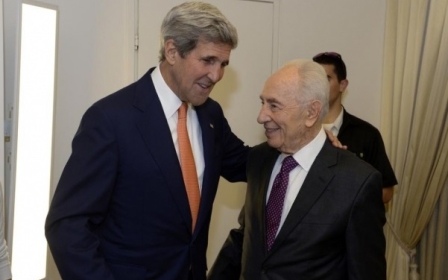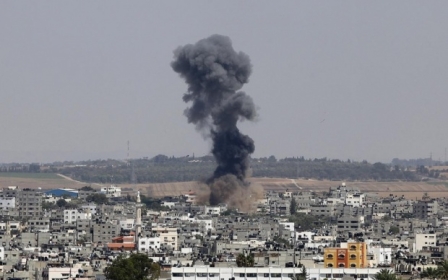Death toll soars in Gaza as Israel unleashes ‘fiercest’ bombardment

GAZA CITY - Palestinians in Gaza say that Israeli attacks last night and this morning were the most aggressive since Israel’s offensive began three weeks ago.
An estimated 60 Palestinians were killed, according to local health officials, as a result of some 60 airstrikes. This takes the death toll in the conflict to 1,137 Palestinians, mostly civilians, since 8 July. Israel has lost 53 soldiers and three civilians, while a Thai worker was also killed.
Israeli F-16 fighter jets bombed Gaza’s fishing harbour, with the targets including a statue that was erected for the victims for Mavi Marmara aid flotilla attack in May 2010, as well as a fishing market, a mosque, and rooms used by the fisherman of Gaza.
“This is the most fierce night we ever had,” Aya Humaid told Middle East Eye, adding that the bombing continued from air, sea and ground for 10 hours. “This is the night when Israel has used a scorched earth policy,” Humid adds.
The bombardment came on the second of what should be the most joyous days of the Muslim calendar. Monday’s holiday of Eid al-Fitr was also marked by mourning and bloodshed in the Gaza Strip, following three weeks of merciless fighting.
On Monday afternoon, Israeli troops had told civilians in Jabalya and Gaza City to evacuate their homes to central and western Gaza. However, last night’s bombings on Gaza City focused on those western and central areas.
Tuesday morning saw several attacks in the west of Gaza city. An Israeli missile hit the home of Hamas deputy political chief in Gaza Ismail Haniya. The son of Ismail Haniya commented on the incident some hours later saying: “one drop of blood from a Palestinian child is more precious than all our homes.”
The escalation comes after Israeli Prime Minister Benjamin Netanyahu vowed not to end the Gaza operation “without neutralizing the tunnels” and the defense minister warned of “many more days” before a truce.
However, the attacks carried out on Tuesday morning focused on residential areas and civilian infrastructure, including the fuel tanks of Gaza’s only power plant and carton and soft drinks factories on Salahddin road.
Firefighters have been unable to cope with the massive fire damage caused by the attacks early Tuesday. Other governmental buildings were also targeted by F16 missiles, including the Finance Ministry, witnesses said.
The only power plant supplying electricity to the Gaza Strip was knocked out of commission by Israeli shelling, deputy director of the energy authority in the Palestinian territory said Tuesday.
Several mosques were hit, including the al Amin mosque which faces a house of Palestinian President Mahmoud Abbas. The mosque was hit three times Tuesday morning.
Netanyahu said on Monday that Israelis should ready for a long military campaign in Gaza, after Hamas mortar fire from the enclave killed four Israeli soldiers.
Mazen Hawleh from Jabaliya says there is clear escalation in the targeting of civilians.
“Israeli warplanes have targeted all aspects of life, even a shop that sells paints have been targeted.” Hawleh wonders what threat there could be a in this. “Artillery shelling continues only hitting us civilians in Jabaliya,” he adds.
"We must be prepared for a lengthy campaign," Netanyahu said in a speech that was broadcast live soon after the news of the shelling of the Eshkol region that also reportedly wounded at least 12 soldiers.
In Khan Yunis, citizens say that humanitarian crisis is intensifying as electricity outages have affected the telecommunications services for around 250,000 inhabitants.
A local resident of Khan Yunis, Abu Fouad, says that he was unable to connect with ambulance crews to inform them about injured people in his neighbourhood.
As Israeli F-16 missile hit the homes of the al Najjar family where 20 family members were killed. The airstrike hit the family without prior warning. Families were unable to make phone calls to ambulances and rescue teams because the telecommunications network is down. Instead, tens of private cars transferred victims of the attacks to Nasser hospital.
On Tuesday morning, neighbours of the al Najjar family said that there are still more victims of the al Najjar family still under the ruins and that they were waiting for bulldozers to dig out their bodies.
Last Saturday morning, 21 family members were killed from Al Najjar family. The incident triggered anger among the population.
Several entire families were wiped out in the overnight strikes in southern and central Gaza to Rafah. One of the homes targeted without prior warning was in Rafah and belongs to the Abu Zaid family.
Abu Yousef Al Najjar, a hospital doctor, said seven people were killed in that attack on the Abu Zaid family home, with dozens injured. Rescue teams are still digging out more bodies from the three-storey house. Residents in Rafah say there was no reason the family should have been targeted.
The home of the Mayor of Buriej, in the central Gaza Strip was hit by several Israeli missiles. So far health officials have said that four were killed in that strike.
During early morning hours, Israeli warplanes targeted the al-Shrouq Tower, a building which hosts several international and local TV channels. The target seems to be Hamas’s al-Aqsa Voice Radio.
A live broadcast was cut short during an announcement released by the Qassam Brigades referred to a press statement on rockets being fired on Tel Aviv.
Among the other five different buildings attacked is the headquarters of the al Aqsa Satellite Channel in Gaza City.
The Palestinian Journalist Syndicate has condemned the attack and called for the International Federation of Journalists to send a fact finding mission to investigate crimes on press freedom and journalists.
In a press statement, al Aqsa network said that the attack will not stop it from broadcasting the suffering and steadfastness of the Palestinian people. “Targeting media shows bankruptcy and blunder, and what happened is a clear violation to press freedom”
Middle East Eye propose une couverture et une analyse indépendantes et incomparables du Moyen-Orient, de l’Afrique du Nord et d’autres régions du monde. Pour en savoir plus sur la reprise de ce contenu et les frais qui s’appliquent, veuillez remplir ce formulaire [en anglais]. Pour en savoir plus sur MEE, cliquez ici [en anglais].




